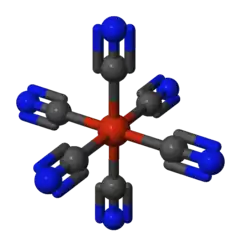Ferrocyanide
Ferrocyanide is the name of the anion [Fe(CN)6]4−. Salts of this coordination complex give yellow solutions. It is usually available as the salt potassium ferrocyanide, which has the formula K4Fe(CN)6. [Fe(CN)6]4− is a diamagnetic species, featuring low-spin iron(II) center in an octahedral ligand environment. Although many salts of cyanide are highly toxic, ferro- and ferricyanides are less toxic because they tend not to release free cyanide.[1] It is of commercial interest as a precursor to the pigment Prussian blue and, as its potassium salt, an anticaking agent.

Reactions
Treatment of ferrocyanide with ferric-containing salts gives the intensely coloured pigment Prussian blue [1] (sometimes called ferric ferrocyanide and ferrous ferricyanide).
Ferrocyanide may undergo oxidation, resulting in ferricyanide:
- [Fe(CN)6]4− ⇌ [Fe(CN)6]3− + e−
This conversion can be followed spectroscopically at 420 nm, since ferrocyanide has negligible absorption at this wavelength while ferricyanide has an extinction coefficient of 1040 M−1 cm−1.[2]
Research
Ferrocyanide and its oxidized product ferricyanide cannot freely pass through the plasma membrane. For this reason ferrocyanide has been used as a probe of extracellular electron receptor in the study of redox reactions in cells. Ferricyanide is used thus any increase in ferrocyanide can be attributed to secretions of reductants or transplasma membrane electron transport activity.
It has been studied as an electrolyte in flow batteries.[3][4]
Nomenclature
According to the recommendations of IUPAC, ferrocyanide should be called "hexacyanidoferrate(II)". Cyanides as a chemical class were named because they were discovered in ferrocyanide. Ferrocyanide in turn was named in Latin to mean "blue substance with iron." The dye Prussian blue had been first made in the early 18th century. The word "cyanide" used in the name is from κύανος kyanos, Greek for "(dark) blue."
See also
- Ferricyanide
- Perls' Prussian blue a histology stain
- Potassium ferrocyanide
- Sodium ferrocyanide
References
- Holleman, A. F.; Wiberg, E. (2001). Inorganic Chemistry. San Diego: Academic Press. ISBN 0-12-352651-5.
- Appleby, C. A.; Morton, R. K. (1959). "Lactic dehydrogenase and cytochrome b2 of baker's yeast: Purification and crystallization". Biochem. J. 71: 492–499.
- Holy Grail of energy policy in sight as battery technology smashes the old order (telegraph.co.uk) |https://www.telegraph.co.uk/business/2016/08/10/holy-grail-of-energy-policy-in-sight-as-battery-technology-smash/
- Developing Organic Flow Batteries for Energy Storage (arpa-e.gov) http://arpa-e.energy.gov/sites/default/files/documents/files/HarvardFlowBattery_OPEN2012_ExternalProjectImpactSheet_FINAL.pdf